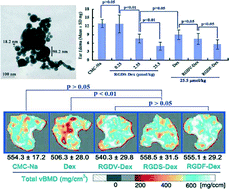RGD-peptides modifying dexamethasone: to enhance the anti-inflammatory efficacy and limit the risk of osteoporosis†
Abstract

* Corresponding authors
a
Beijing area major laboratory of peptide and small molecular drugs, Engineering Research Center of Endogenous Prophylactic of Ministry of Education of China, Beijing Laboratory of Biomedical Materials, College of Pharmaceutical Sciences, of Capital Medical University, Beijing 100069, PR China
E-mail:
mingzhao@bjmu.edu.cn, sqpeng@bjmu.edu.cn
Fax: 86 10 8391 1528
Tel: 86 10 8391 1528
b School of Life Science, Jiangxi Normal University of Science and Technology, Nanchang, China
c Faculty of Biomedical Science and Environmental Biology, Kaohsiung Medical University, Kaohsiung, Taiwan

 Please wait while we load your content...
Something went wrong. Try again?
Please wait while we load your content...
Something went wrong. Try again?
H. Yu, S. Mei, L. Zhao, M. Zhao, Y. Wang, H. Zhu, Y. Wang, J. Wu, C. Cui, W. Xu and S. Peng, Med. Chem. Commun., 2015, 6, 1345 DOI: 10.1039/C5MD00215J
To request permission to reproduce material from this article, please go to the Copyright Clearance Center request page.
If you are an author contributing to an RSC publication, you do not need to request permission provided correct acknowledgement is given.
If you are the author of this article, you do not need to request permission to reproduce figures and diagrams provided correct acknowledgement is given. If you want to reproduce the whole article in a third-party publication (excluding your thesis/dissertation for which permission is not required) please go to the Copyright Clearance Center request page.
Read more about how to correctly acknowledge RSC content.
 Fetching data from CrossRef.
Fetching data from CrossRef.
This may take some time to load.
Loading related content
